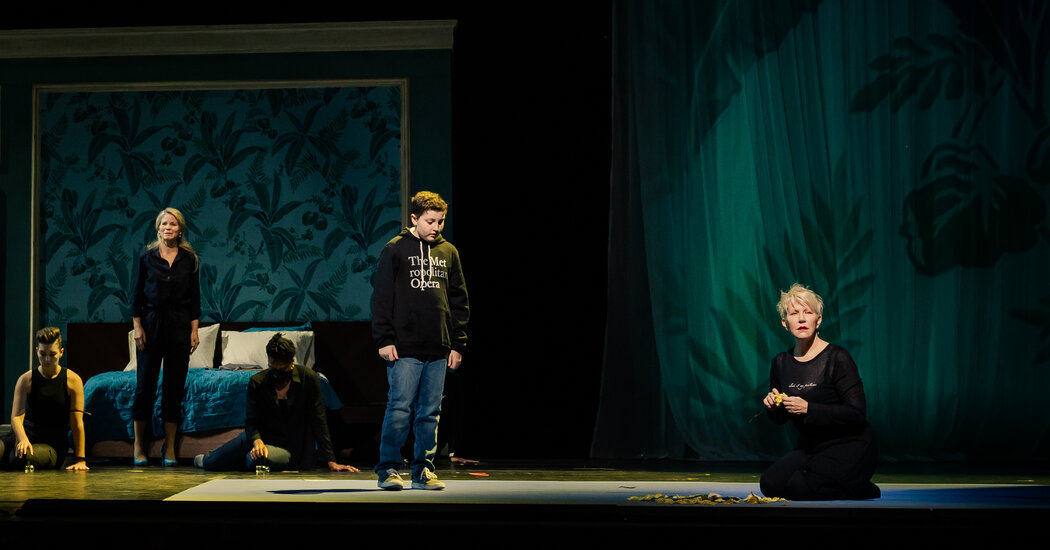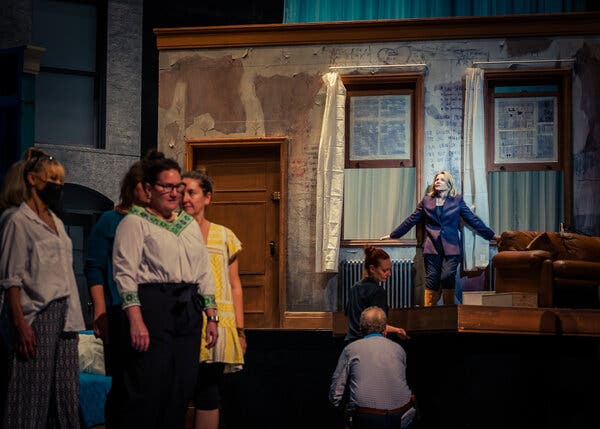
“I think it needs to be more surreal,” the conductor Yannick Nézet-Séguin said from the orchestra pit of the Metropolitan Opera on a recent afternoon.
The scene onstage was nothing but surreal — fragmented light beams suggesting a proscenium; towering, billowing curtains lit in dreamy shades of blue, their translucence revealing the impression of a building facade beyond. Yet Nézet-Séguin, the Met’s music director, was more interested in another element: the chorus, offstage and coloristic, an otherworldly fixture of an otherworldly environment.
None of that is reminiscent of “The Hours” in its earlier iterations: Michael Cunningham’s Pulitzer Prize-winning 1998 novel; or the 2002 Stephen Daldry film, which was defined as much by its tensely churning Philip Glass score as by its Oscar-bait trio of leading stars, Nicole Kidman, Julianne Moore and Meryl Streep.
But this is “The Hours” as adapted from both the book and the film by the writer Greg Pierce and the composer Kevin Puts. It is rendered as only opera can be: with an interplay of divas — Renée Fleming, Kelli O’Hara and Joyce DiDonato — who are enveloped by a restless and lush orchestra, and share a dream space with an ensemble of dancers who guide and observe them in Phelim McDermott’s staged premiere of the work, which opens at the Met on Tuesday.

Renée Fleming — joined here by chorus members, the stage manager Scott Moon, kneeling, and the actress Andrea Lucaciu — said she “loved, loved, loved” Stephen Daldry’s 2002 film adaptation of “The Hours.”Credit…Dina Litovsky for The New York Times
“When I met Michael Cunningham,” Nézet-Séguin recalled, “he said that as a writer, words for him have to be sequential. You can’t superimpose words. But that’s where opera can melt and create parallels with the stories in real time.”
AS A NOVEL, “The Hours” contains three interwoven stories, each unfolding for the most part quietly, over the course of a single day: Virginia Woolf struggles with depression while writing “Mrs. Dalloway”; Laura Brown, a homemaker in Southern California in 1949, feels oppressed by small tasks like baking a cake while just wanting to read that novel; and Clarissa Vaughan, an editor living in New York City half a century later, seems to embody “Mrs. Dalloway” as she prepares a party for her friend and former love Richard, a poet ravaged by AIDS.
Fleming “loved, loved, loved” the Daldry film, she said in an interview over the summer. Some had thought she had made her farewell to staged opera in 2017, as the Marschallin in Strauss’s “Der Rosenkavalier,” one of her signature roles. But she was quickly looking for a new project at the Met, and her right-hand man, Paul Batsel, suggested an adaptation of the story by Puts. Fleming was into the idea; so was Peter Gelb, the Met’s general manager.
The work would require three singers on the level of the film’s stars. Fleming took on Streep’s role, as Clarissa; then came DiDonato as Virginia Woolf (played by Kidman in the movie); and, Kelli O’Hara as Laura (Moore). O’Hara has made a career as a decorated Broadway star but is such an opera natural that she was the highlight of Mozart’s “Così Fan Tutte” in 2018.
“I remember reading the book so hungrily,” she said. “The commentary on this time period, the survival, mental health, which I think is so appropriate right now. It just spoke to me so deeply.”
In writing the opera, Pierce and Puts exploited what previous forms of the story couldn’t. “Some films have tried simultaneity,” Puts said. “But because of the nature of harmony and rhythmic notation, you can have things overlap here, and that’s very exciting. What you have to decide on is one sort of primary backdrop, musically, that unifies them. And that became interesting for me.”
Puts’s score — which is written through, eclectic and soaringly lyrical — contains dreamy touches befitting the fluid nature of Pierce’s text, which has nearly 30 scenes that dissolve in and out of one another. A countertenor role, sung at the Met by John Holliday, in which the singer appears in different guises, can be seen as something like an angel of death or ferryman. A children’s chorus that Richard, the dying poet, hears in his head turns out to be the nieces and nephews of Virginia Woolf, holding a funeral for a bird. Other recursive phrases include music associated with Virginia that Clarissa overhears from a church choir.
“What’s the meaning of that?” Puts said. “I’m not even sure what the answer is, but I think that’s what can be interesting.”
Haunting the music is Glass’s Minimalist soundtrack for the “Hours” film. Puts called it “a beautiful score,” and recognized the danger in putting up his own work against it. “It’s almost like, would you write a ‘Star Wars’ opera?” he said, referring to John Williams’s famous music for that franchise. “No, I wouldn’t. It would be the dumbest thing in the world because it’s so iconic.”
But, Puts added, while there are suggestions of a Minimalist style in the “Hours” opera — not for the first time in his compositional career — the work organically developed into something else. “The opera is so different that it’s its own thing,” he said. Nézet-Séguin described the score as having “just enough Minimalism,” but bringing “it to another, more lyrical, approach.”
With the cast in place early, Puts tailored the score to Fleming, DiDonato and O’Hara. “I imagine if you’re writing a screenplay and you know Robert De Niro is going to play this character,” he said, “then every line you write, you imagine him delivering it.” And, he added, he is happy to reflect the specificity of their sounds and revise accordingly during rehearsals rather than plan for later productions and casts: “In a case like this, I’m not as concerned about the future.”
All three stars have responded positively to the way their roles sit in their voices. This summer, DiDonato said that while reading through the score, she would tell herself, “Oh, Kevin, that’s the money note.” And Fleming, who has worked with Puts before — “He knows my voice really well” — said that his writing was singer friendly, with phrases separated, “so you’re not really stuck in a high register or a challenging tessitura consistently.”
Puts developed a sound world for each woman. Clarissa’s, he said, is quintessentially American. Virginia’s draws on piano and an ornamental language befitting an earlier time in the English countryside, but with a winding harmony that, he hopes, evokes Woolf’s writing. Laura’s music, however, is more like that of her husband — of darkly cheery post-World War II domesticity that becomes something of a prison for her to escape from. All three come together in the finale, in a succession and layering of style.
Nézet-Séguin conducted the world premiere with the Philadelphia Orchestra in March, and felt, hearing it for the first time, that “Kevin got so much right.” A few things have changed between then and now: the tessitura of the chorus, for instance, and some cuts along with additions. Crucially, the Met’s presentation is different simply for being staged.
McDERMOTT, whose Met credits include blockbuster productions of Glass’s “Satyagraha” and “Akhnaten,” had been told that the opera’s constant shifting of time and place would make it “impossible” to direct. Yet he took it on, joined by the choreographer Annie-B Parson, the mind behind the infectiously exuberant movement in David Byrne’s “American Utopia.”
“It’s like directing three operas on top of each other,” McDermott said. “There are so many scenes, and it’s filmic, so you need to get from place to place in a way that’s enjoyable rather than holding weight.”
McDermott and Parson have long been at work on “The Hours,” including a workshop over the summer, months before the singers arrived for rehearsals. “I was given time with the dancers first,” Parson said, “which was very luxurious.” She didn’t end up using everything but experimented with having them “defy the weight of the architecture” in magical ways that included blowing sets with their breath to move them, or occupying the set like cats — observational and impossible to read.
Parson said she has been guided in part by Woolf herself. “Experimentation was the heart of work,” she said. “That was always on my mind — gender fluidity, feminism — and I wanted to start with her.”
The dancers, McDermott said, “set the atmosphere of the scenes.” They are involved with maintaining the action’s momentum, but they also move with a vocabulary that is sometimes in harmony with scenes across time, like spirits. The choreography, Parson said, is “an embroidery of these worlds.”
A week before opening night, the opera’s many moving parts were still finding their places. There was talk of many tears during rehearsals, but there has also been laughter. An emotional high point — Richard’s suicide by falling out a window — was a clunky comedy of errors that had DiDonato, who was watching from a seat in the auditorium, joking, “Guffman called.”
McDermott referred to this as the moment that comes in any rehearsal process when it’s difficult to avoid thinking, “Oh my God, we’ve taken on too much.”
Then, he added, something tends to happen. “You want all the performers and musicians to be resonating with each other in a perfect, beautiful way,” he said. “Then the piece begins to speak to itself. But what I’ve noticed is, it doesn’t really turn up until the audiences comes. That’s when you’ll see how strong the atmosphere can be.”